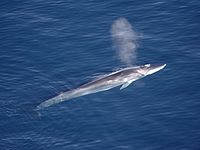
Photo from wikipedia
Observations of the diversity, distribution and abundance of pelagic fauna are absent for many ocean regions in the Atlantic, but baseline data are required to detect changes in communities as… Click to show full abstract
Observations of the diversity, distribution and abundance of pelagic fauna are absent for many ocean regions in the Atlantic, but baseline data are required to detect changes in communities as a result of climate change. Gelatinous fauna are increasingly recognized as vital players in oceanic food webs, but sampling these delicate organisms in nets is challenging. Underwater (in situ) observations have provided unprecedented insights into mesopelagic communities in particular for abundance and distribution of gelatinous fauna. In September 2018, we performed horizontal video transects (50–1200 m) using the pelagic in situ observation system during a research cruise in the southern Norwegian Sea. Annotation of the video recordings resulted in 12 abundant and 7 rare taxa. Chaetognaths, the trachymedusa Aglantha digitale and appendicularians were the three most abundant taxa. The high numbers of fishes and crustaceans in the upper 100 m was likely the result of vertical migration. Gelatinous zooplankton included ctenophores (lobate ctenophores, Beroe spp., Euplokamis sp., and an undescribed cydippid) as well as calycophoran and physonect siphonophores. We discuss the distributions of these fauna, some of which represent the first record for the Norwegian Sea.
Journal Title: Polar Biology
Year Published: 2021
Link to full text (if available)
Share on Social Media: Sign Up to like & get
recommendations!